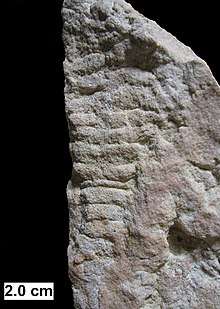Mosineia
Mosineia is a genus of euthycarcinoid arthropods that lived on tidal flats of Laurentia at what is now central Wisconsin from the Middle Cambrian to the Late Cambrian.[1] It contains a single species, Mosineia macnaughtoni. Associated trace fossil evidence suggests that this genus spent some of its time subaerially, possibly to mate and to feed on the microbial mats that blanketed the beaches.[2] The genus is named after Mosinee---the city in Marathon County, Wisconsin, near which the fossils were found. The collecting site is known as Blackberry Hill, which is a well known Konservat-Lagerstätte that produces abundant exceptionally preserved fossils.
| Mosineia | |
|---|---|
 | |
| The euthycarcinoid Mosineia macnaughtoni from the Elk Mound Group of Wisconsin; ventral view | |
| Scientific classification | |
| Kingdom: | Animalia |
| Phylum: | Arthropoda |
| Genus: | †Mosineia Collette & Hagadorn 2010 |
| Species: | †M. macnaughtoni |
| Binomial name | |
| †Mosineia macnaughtoni Collette & Hagadorn 2010 | |

History of discovery
The discovery of Mosineia was a milestone in geologic history. Since the mid-1800s, trackways named Protichnites (Greek for "first footprints") had been found on Cambrian beach strata in North America. Whatever animal produced them was one of the first to emerge from the sea; however, the identity of that animal remained unknown.[3] The new fossils, found in the late 1900s and early 2000s, including body fossils of the animal itself (Mosineia) and fossils linking that animal to the trackways, thus solved a mystery that had lasted over 150 years.[4][5][6][7]
References
- Collette, Joseph H.; Hagadorn, James W. (2010). "Three-dimensionally preserved arthropods from Cambrian Lagerstätten of Quebec and Wisconsin". Journal of Paleontology. 84 (4): 646–667. doi:10.1666/09-075.1.
- Collette, Joseph H.; Gass, Kenneth C.; Hagadorn, James W. (2012). "Protichnites eremita unshelled? Experimental model-based neoichnology and new evidence for a euthycarcinoid affinity for this ichnospecies". Journal of Paleontology. 86 (3): 442–454. doi:10.1666/11-056.1.
- Owen, Richard (1852). "Descriptions of the impressions and footprints of the Protichnites from the Potsdam sandstone of Canada". Geological Society of London Quarterly Journal. 8 (1–2): 214–225. doi:10.1144/GSL.JGS.1852.008.01-02.26.
- Gass, Kenneth C. (2015). Solving the mystery of the first animals on land: The fossils of Blackberry Hill. Siri Scientific Press. ISBN 978-0-9929979-5-3.
- Krapovickas, Verónica M.; Mángano, Gabriella; Buatois, Luis A.; Marsicano, Claudia A. (2016). "Integrated ichnofacies models for deserts: Recurrent patterns and megatrends". Earth-Science Reviews. 157: 61–85. doi:10.1016/j.earscirev.2016.03.006.
- Lozano-Fernandez, Jesus; Carton, Robert; Tanner, Alastair R.; Puttick, Mark N.; Blaxter, Mark; Vinther, Jakob; Jørgen, Olesen; Giribet, Gonzalo; Edgecombe, Gregory D.; Pisani, Davide (2016). "A molecular palaeobiological exploration of arthropod terrestrialization". Philosophical Transactions of the Royal Society B. 371: 20150133. doi:10.1098/rstb.2015.0133.
- Edgecombe, Gregory D.; Strullu-Derrien, Christine; Góral, Tomasz; Hetherington, Alexander J.; Thompson, Christine; Koch, Marcus (2020). "Aquatic stem group myriapods close a gap between molecular divergence dates and terrestrial fossil record". Proceedings of the National Academy of Sciences. 117 (16): 8966–8972. doi:10.1073/pnas.1920733117.